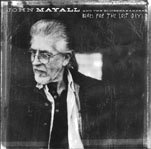|
John Mayall and the Bluesbreakers Blues for the Lost Days Silvertone 01241-41605-2 |

|
|
John Mayall and the Bluesbreakers Blues for the Lost Days Silvertone 01241-41605-2 |

|
The ironies about his career are abundant: Though having been credited with helping launch many a storied British bluesmen's career, Mayall never had a hit record (despite FM radio's fleeting infatuation with "Room to Move"). And, as a man whose early band was a virtual revolving door of young, hungry players, his current line-up has remained unchanged (with the exception of Texan guitarist Buddy Whittington replacing Coco Montoya) for more than a decade.
Less than two years since Spinning Coin, Blues for the Lost Days finds Mayall in an uncharacteristically reflective mood, penning tributes to his undoubtedly patient wife ("I Don't Mind"), his mother ("One in a Million"), his childhood discovery of American blues ("All Those Heroes") and a touching and occasionally funny toast to the days of whiskey-soaked, chump-change gigging ("Blues for the Lost Days").
That Mayall seems comfortable acknowledging his past is less remarkable, perhaps, than the plaintive, street-corner poetics of the tributes themselves. "Six thousand miles between us/Don't think about that now/Telephones and photographs have got to do somehow," he sings to his mother. The chill breath of mortality blows through stuff like this, and it comes across even chillier described only by the detectable strains of desperation in Mayall's reedy voice. Like any good bluesman, Mayall lets you know that he's running -- he just seems to be sweating a little less.
For their part, the Bluesbreakers remain essentially a vehicle for Mayall's writing and keen sense of arrangement. At the core, of course, is the guitar seat, currently and ably occupied by Whittington, who always plays his role with taste and restraint. Less flashy and a good deal more economical than his predecessor, Whittington picks his battles carefully and plays to win: the foot-thick, snarling "Dead City," the jumpy, surfish picking through the instrumental "Sen-Say-Shun" and the squeaky flat picking of "You Are for Real" speak to Whittington's long history of honky-tonk dues.
Mayall's band hasn't really been a star player's showcase for 30 years (since you-know-who), and Whittington seems to know this, filling and accenting (especially on the horn-driven Eddie Harris cover "How Can You Live Like That?") like he's actually listening to the rest of the band, not just biding his time till the next solo.
But the real instrumental weapon this band has is Mayall's piano playing. Spicy and well-informed, it brings a depth and sophistication to otherwise spare bits like "I Don't Mind" and the nicely drawn interplay between piano and organ on the fade to "One in a Million." Long revered as a harmonica god, Mayall is actually a superb piano player, and it's a mystery that he plays it down so much.
-- David Kirby